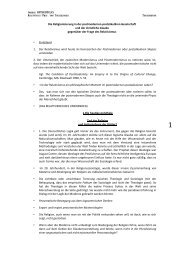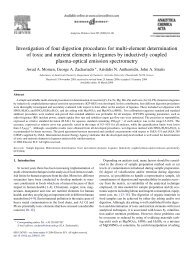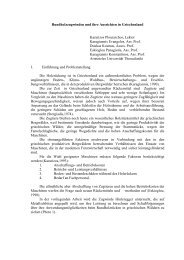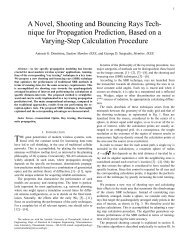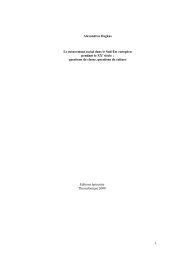an alternative proposal for the design of balanced cantilever bridges ...
an alternative proposal for the design of balanced cantilever bridges ...
an alternative proposal for the design of balanced cantilever bridges ...
Create successful ePaper yourself
Turn your PDF publications into a flip-book with our unique Google optimized e-Paper software.
8 Proceedings IBSBI 2011<br />
construction method is employed. The dead load <strong>of</strong> <strong>the</strong> bridge deck, which<br />
typically constitutes <strong>the</strong> largest portion <strong>of</strong> <strong>the</strong> bridge’s vertical loading, is<br />
decreased due to <strong>the</strong> reduction in <strong>the</strong> height <strong>of</strong> <strong>the</strong> deck cross section.<br />
However, <strong>the</strong> variation <strong>of</strong> <strong>the</strong> deck cross section along <strong>the</strong> bridge deck<br />
obstructs <strong>the</strong> falsework as <strong>the</strong> scaffolding is more dem<strong>an</strong>ding in terms <strong>of</strong><br />
geometry, compared to <strong>the</strong> conventional segmental bridge construction.<br />
• The bridge aes<strong>the</strong>tics are signific<strong>an</strong>tly improved compared to <strong>the</strong><br />
conventional segmental bridge construction. This is due to <strong>the</strong> refined archtype<br />
view <strong>of</strong> <strong>the</strong> bridge constructed by <strong>the</strong> proposed method <strong>an</strong>d <strong>the</strong> reduced<br />
deck cross section height.<br />
• As far as it concerns <strong>the</strong> cracking <strong>of</strong> <strong>the</strong> deck, <strong>the</strong> proposed construction<br />
method c<strong>an</strong> be utilized <strong>for</strong> <strong>the</strong> construction <strong>of</strong> <strong>bridges</strong> with short to medium<br />
sp<strong>an</strong>s up to 35 m. The check against cracking due to <strong>the</strong> short term vertical<br />
loading <strong>of</strong> <strong>the</strong> deck, namely against <strong>the</strong> infrequent loading, showed that <strong>the</strong><br />
deck does not exhibit cracking. In case <strong>of</strong> <strong>bridges</strong> with longer sp<strong>an</strong>s up to<br />
50m <strong>the</strong> use <strong>of</strong> partial prestress shall be used.<br />
• The deflections <strong>of</strong> <strong>the</strong> deck were signific<strong>an</strong>tly reduced due to <strong>the</strong> objective<br />
set during <strong>the</strong> <strong>design</strong> <strong>of</strong> <strong>the</strong> prestressing <strong>for</strong>ce, which ensured that <strong>the</strong><br />
c<strong>an</strong>tilevers had a pre-cambering upwards, at least when <strong>the</strong> scaffolding was<br />
removed.<br />
• Possible differential settlements <strong>of</strong> <strong>the</strong> piers c<strong>an</strong> be received by <strong>the</strong> resulting<br />
bridge system without developing high bending loading to <strong>the</strong> deck, due to<br />
flexibility <strong>of</strong> <strong>the</strong> arch-type superstructure.<br />
REFERENCES<br />
[1] CALTRANS, “Bridge Design Aids M<strong>an</strong>ual”, Cali<strong>for</strong>nia Department <strong>of</strong> Tr<strong>an</strong>sportation,<br />
Sacramento, 1994.<br />
[2] Chen WF <strong>an</strong>d Du<strong>an</strong> L, Bridge Engineering H<strong>an</strong>dbook, CRC Press Boca Raton London, New<br />
York Washington, D. C., 1999, Chapter 1.<br />
[3] Trost H., Lastverteilung bei Plattenbalkenbrucken, Werner Verlag, Dusseldorf, West<br />
Germ<strong>an</strong>y, 1961.<br />
[4] Kwak H-G <strong>an</strong>d Son J-K, “Determination <strong>of</strong> <strong>design</strong> moments in <strong>bridges</strong> constructed with a<br />
movable scaffolding system (MSS)”, Computers <strong>an</strong>d Structures, Vol. 84, Issue 31-32, pp.<br />
2141-2150, 2006.<br />
[5] EN 1992-1-1:2004 Eurocode 2: Design <strong>of</strong> concrete structures, Part 1-1: General rules <strong>an</strong>d<br />
rules <strong>for</strong> buildings, 2004.<br />
[6] DIN-Fachbericht 102, Betonbrücken, DIN Deutsches Institut fuer Normung e.V, 2003.<br />
[7] EN 1991-2:2003 Eurocode 1: Actions on structures - Part 2: Traffic loads on <strong>bridges</strong>, 2003.<br />
[8] EN 1992-2:2004 Eurocode 2: Design <strong>of</strong> concrete structures-Part 2: Bridges, 2004.<br />
[9] EN 1998-2:2005 Eurocode 8: Design <strong>of</strong> structures <strong>for</strong> earthquake resist<strong>an</strong>ce, Part 2: Bridges,<br />
2005.



